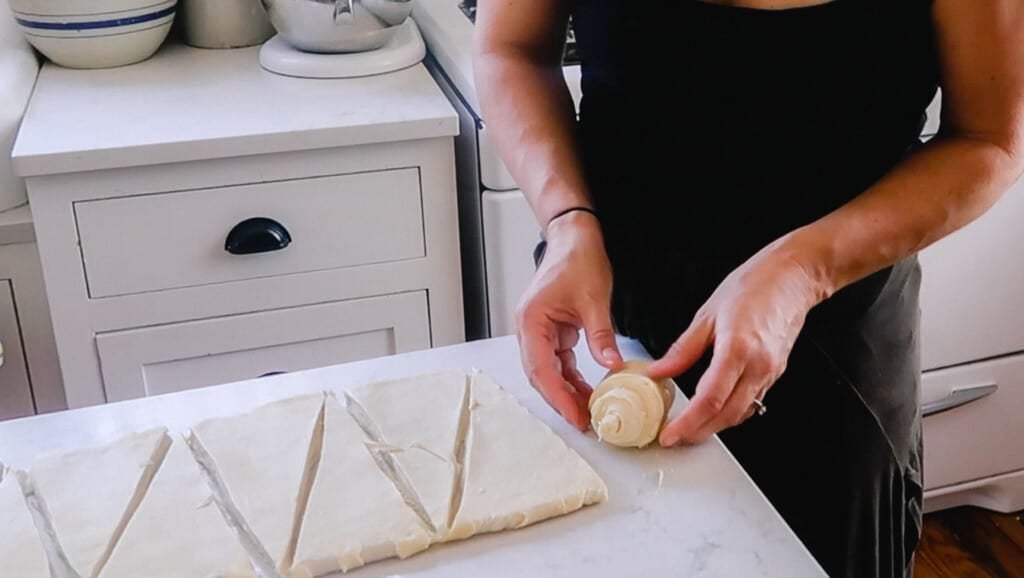These flaky, buttery sourdough croissants are one of the most decadent sourdough recipes I’ve ever enjoyed. Layers of sourdough pastry dough and layers of butter are shaped and baked. These make the perfect brunch sandwich bread, a fancy breakfast, or a wonderful holiday roll.

There really isn’t anything much more decadent than sourdough crescent rolls. They are a bit of a labor of love, but the flavor and texture are totally worth it.
After multiple attempts and multiple fails, I finally perfected these seriously good croissants. Below, you will find step-by-step instructions and tips so you don’t have to have the same issues that I had.
Make sure to watch the video, as well, to really understand the process.
Even the not-so-perfect attempts were seriously delicious.
These are a definite step up from the croissants you get from a can. They are flaky, buttery, and slightly tangy from the fermented dough. Yum.
Perfect for holidays, to make a fancy sandwich for a brunch, or a seriously decadent French toast casserole for breakfast, these rolls are so versatile.

Tips:
- Make sure to roll them tightly. I didn’t roll them tight enough in one of my attempts and they were kind of a fail. A delicious fail, but for the right shape and flakiness, they need to be tight.
- Big key during the lamination is for the dough to never get too warm. (If it does, the butter will just melt into the dough and you will have something more like brioche as opposed to croissants with flaky layers.)
- During the lamination process, you have to work fairly quickly because you don’t want the butter to get too soft. If it does, you can stick it in the fridge for 30 minutes and then continue working on the dough.
This post contains affiliate links, which means I make a small commission at no extra cost to you. See my full disclosure here.

Ingredients:
Butter – Lots of butter. But this is what gives the super flaky layers.
Flour – All-purpose flour will work just fine. No need for anything special here.
Sugar
Salt – Brings out all the flavor of the butter and flaky layers.
Milk – Choose whole milk for the best results. This is not a low fat recipe by any means. All that fat helps make those layers. Don’t skip it.
Sourdough starter: The starter needs to be active and bubbly. This is what gives the croissant rise and also helps break down the gluten and make the nutrients more bio-available.
Egg yolk – This is to create an egg wash which gives it the most amazing golden color.

Tools you may need:
Measuring cups and spoon
Rolling pin
Baking sheet
FAQ:

How do you proof a sourdough croissant?
After the dough is made, you want to let it sit at room temperature overnight or at least 8 hours. This proofs the dough. It takes longer than traditional croissants that use commercial yeast.
Are sourdough croissants healthier?
Sure. The wild yeasts in the sourdough starter help ferment the grains and break down the gluten, making them easiest to digest. They also help break down the anti-nutrients present in the grains, making the vitamins and minerals present in the grains easier for your body to absorb.
Can you freeze sourdough croissants?
Yes. Wrap the sourdough croissants in plastic wrap and then place in a freezer bag. Try to take out as much air from the bag as possible. Place in the freezer for up to 2 months.

What can I fill my croissant with?
Some of these ideas should be done after baking and some before.
- Chocolate chips – Before baking
- Marshmallows – Ever done the Jesus rising from the tomb experiment with the kids at Easter? Place a mini marshmallow in the middle and fold over the dough, sealing it around the edges. Bake, then discover that the marshmallow “magically” disappears.
- Nutella – Before or after baking
- Cheese: Shredded cheese, brie cheese, goat cheese, or mozzarella. Before or after baking.
- Caramelized onions – After baking
- Pastry cream – After baking when croissants are completely cooled
- Ice cream – After baking when croissants are completely cooled
- Fresh fruit – After baking
Why do you leave croissant dough overnight?
Leaving the dough overnight allows the yeasts and bacteria in the sourdough to ferment the flour which breaks down the gluten and the anti-nutrients in the grains. This in turn makes the vitamins and minerals easier for your body to digest.
Should croissants be refrigerated?
No, after baking, croissants do not need to be refrigerated.
What is the difference between croissants and crescent rolls?
Croissants use the laminating process to create the fluffy flaky layers, whereas crescent rolls use yeast to give them rise.
These croissants with sourdough starter are technically a combination of both.
How do you keep croissants fresh for a week?
Freeze them in an air-tight container until you are ready to use them.

How To Make Sourdough Croissants

Create the dough
Knead dough. Add everything (except the 1.5 cups butter and the egg yolk) to a stand mixer and allow it to knead until it pulls away from the sides of the bowl and is glossy and stretchy. About 10 minutes on medium/low speed) should do.
Transfer the dough to a lightly greased bowl and cover tightly, using a lid, plastic wrap, or beeswax wraps.

Allow to sit at room temperature overnight or 8 hours. This is the bulk ferment to get all of those sourdough benefits.
Prepare The Dough For Lamination
Chill the dough for 1 hour so that it is easier to work with.

Roll out dough to 10” by 16”.
Chill for 4 hours, or overnight.
Prepare butter

I like to place the parchment paper onto my work surface and, using a ruler and pencil, make that size of rectangle as a template.

Cut the sticks of butter in about fourths vertically, and lay them out on parchment paper, creating an 8” by 10” rectangle.

Fold the sides of the parchment up around the butter, creating a little 8” by 10” packet. Fold the parchment all around.

Using a rolling pin, roll on top of it so that the butter fills the area. You want a 8 by 10 inch rectangle of butter.
Chill for 15-30 minutes. You want the butter to be about the same consistency as the dough, not super hard. If it is harder than the dough it will break up as opposed to creating a nice layer between the dough (see troubleshooting).
If the dough chills for several hours, and the butter for about 20 minutes, they should be about the same consistency.
Lamination

Peel the butter off of the parchment paper and put the butter in the middle of the dough and fold the sides over so that you basically create an envelope for the butter.

Pinch the edges down. You shouldn’t see the butter at all, as it should be entirely encased in the croissant dough.
Roll out to 10” by 16” rectangle.
If the dough springs back or resists at all, put it in the fridge and allow the gluten to relax a bit. You don’t want to press the butter in too much so that it actually incorporates into the dough. You are trying to create layers!
Fold the dough/butter into thirds.
Tap the dough with the rolling pin so the butter is pliable yet not melted.
Roll out to 10 by 16 again and fold in thirds again.
*Big key during the lamination is for the dough to never get too warm. If it does, the butter will just melt into the dough and you will have something more like brioche as opposed to croissants with flaky layers. So at this point, you’ll want to refrigerate for 30 minutes to get it cool again.
Roll out 10 by 16 one more time.
Fold in thirds one more time (for 3 times total).
Put the dough back in the fridge for 4 hours.
Shape

Roll out the dough into 10 by 20 inch rectangle.
Measure every 4” down one long side. Then measure 4” down the other side, starting off set from the 4” on the other side (so that the marks are in the middle of the 4” on the other side).

Cut diagonally from a mark on one side to one on the other, to create a triangle.

Start at large end and tightly roll.
Allow to rise for 2 hours at room temp, or until puffy.
Place in the fridge for an hour. This is optional, but I found that they hold their shape better during baking.
Bake
Preheat oven to 375 degrees.

Brush with egg wash.
Bake for 30 minutes until golden.

TROUBLESHOOTING
If the butter all leaks out during baking, it was probably too cold when you started laminating. You want the consistency of the butter and dough to be similar, so that it doesn’t break up, but instead rolls out in the dough.
I did an experiment where I baked them right after rising, and baked them after chilling for an hour. They definitely held their shape better with the fridge time, but delicious either way.

Storage:
Store in an air-tight container for 1-3 days. Any longer storage, I suggest freezing them.
Freezing:
Wrap the sourdough croissants in plastic wrap and then place in a freezer bag. Try to take out as much air from the bag as possible. Place in the freezer for up to 2 months.
To reheat, place in a 350 degree oven for about 8 minutes.

Baking Schedule
8 PM: Create dough. Allow to bulk ferment overnight.
6 AM: Place the dough in the fridge for one hour.
7 AM: Roll out dough into a rectangle, place in fridge for 4 hours.
11 AM: Roll out butter onto parchment paper. Chill for 15-30 minutes.
11:30 AM: Start the lamination process.
12:00 ish PM: Place back into the fridge for 30 minutes
12:30 PM: Final roll and fold. Place back in fridge for 4 hours.
4:30 PM: Roll out dough and shape. Allow to rise at room temperature for 2 hours or until puffy.
6:30 PM: Bake or place in the fridge for an hour before baking. This helps the croissants hold their shape better.
Find More Decadent Sourdough Recipes:
- Sourdough Chocolate Bread
- Sourdough Brioche
- Brioche French Toast Recipe
- Sourdough Carrot Cake
- Sourdough Chocolate Cake
If you try this recipe and love it, I would love if you gave it 5 stars! Thank you! Tag me on Instagram @farmhouseonboone.
Sourdough Croissants

Ingredients
- 1/4 cup butter
- 3 1/2 cups flour
- 1/4 cup sugar
- 2 teaspoons salt
- 1 1/4 cups milk
- 1/2 cup sourdough starter, active and bubbly
Butter layer
- 1 1/2 cups unsalted butter
Egg Wash
- 1 large egg yolk
Instructions
- Knead dough. Add everything (except the 1.5 cups butter and the egg yolk) to a stand mixer and allow it to knead until it pulls away from the sides of the bowl and is glossy and stretchy. About 10 minutes on medium/low speed) should do.
- Transfer the dough to a lightly greased bowl and cover tightly, using a lid, plastic wrap, or beeswax wraps.
- Allow to sit at room temperature overnight or 8 hours. This is the bulk ferment to get all of those sourdough benefits.
Prepare The Dough
- Chill the dough for 1 hour so that it is easier to work with.
- Roll out dough to 10” by 16”.
- Chill for 4 hours, or overnight.
Prepare butter
- Cut the sticks of butter in about fourths vertically, and lay them out on parchment paper, creating an 8” by 10” rectangle. I like to place the parchment paper onto my work surface and, using a ruler and pencil, make that size of rectangle as a template.
- Fold the sides of the parchment up around the butter, creating a little 8” by 10” packet. Fold the parchment all around.
- Using a rolling pin, roll on top of it so that the butter fills the area. You want a 8 by 10 inch rectangle of butter.
- Chill for 15-30 minutes. You want the butter to be about the same consistency as the dough, not super hard. If it is harder than the dough it will break up as opposed to creating a nice layer between the dough (see troubleshooting). If the dough chills for several hours, and the butter for about 20 minutes, they should be about the same consistency.
Lamination
- Peel the butter off of the parchment paper and put the butter in the middle of the dough and fold the sides over so that you basically create an envelope for the butter. Pinch the edges down. You shouldn’t see the butter at all, as it should be entirely encased in the croissant dough.
- Roll out to 10” by 16” rectangle. If the dough springs back or resists at all, put it in the fridge and allow the gluten to relax a bit. You don’t want to press the butter in too much so that it actually incorporates into the dough. You are trying to create layers!
- Fold the dough/butter into thirds.
- Tap the dough with the rolling pin so the butter is pliable yet not melted.
- Roll out to 10 by 16 again and fold in thirds again. *Big key during the lamination is for the dough to never get too warm. If it does, the butter will just melt into the dough. So at this point, you’ll want to refrigerate for 30 minutes to get it cool again.
- Roll out 10 by 16 one more time.
- Fold in thirds one more time (for 3 times total).
- Put the dough back in the fridge for 4 hours.
Shape
- Roll out the dough into 10 by 20 inch rectangle.
- Measure every 4” down one long side. Then measure 4” down the other side, starting off set from the 4” on the other side (so that the marks are in the middle of the 4” on the other side).
- Cut diagonally from a mark on one side to one on the other, to create a triangle.
- Start at large end and tightly roll.
- Allow to rise for 2 hours at room temp, or until puffy.
- Place in the fridge for an hour. This is optional, but I found that they hold their shape better during baking.
Bake
- Preheat oven to 375 degrees.
- Brush with egg wash.
- Bake for 30 minutes until golden.
Notes
- Make sure to roll them tightly. I didn’t roll them tight enough in one of my attempts and they were kind of a fail. A delicious fail, but for the right shape and flakiness, they need to be tight.
- Big key during the lamination is for the dough to never get too warm. (If it does, the butter will just melt into the dough and you will have something more like brioche as opposed to croissants with flaky layers.)
- During the lamination process, you have to work fairly quickly because you don’t want the butter to get too soft. If it does, you can stick it in the fridge for 30 minutes and then continue working on the dough.
Nutrition
Nutrition information is automatically calculated, so should only be used as an approximation.



















How can I use honey instead of sugar?
Yes, you can!
I was wondering if I could long cold ferment/retard the dough after the bulk ferment. Like maybe 3 days or so? Then start the lamination process? Like mix the dough, stretch and fold, bulk ferment Monday. Then cold ferment in the fridge Monday morning. Then begin the lamination process Thursday evening or Friday morning. And bake them Saturday morning? Thank you!
Yes, you can!
This is the biggest waste of time and ingredients ever. There is now almost a pound of butter on the button of my oven because it ran straight out of the croissants. The fire alarm is going off and I wasted expensive ingredients and two days of my time. Also, the receipt says it makes 12 but following the instructions does not make 12 and the directions video clearly does not either. Highly do not recommend
Wish it had ingredients in grams, would love to try to make these!
I have a conversion chart!
I have your recipe for Italian sourdough rising now and am going to make this today also. I have loved all of the things I’ve made from your site. But I sure wish this one also included weight measurements for ingredients. I’ve gotten so used to baking this way!
I forgot to put the butter packet in somehow, and I made the perfect crescent roll. They were very yummy!
The butter all melted out of my rolls. However, my husband loved them. In the above recipe it says to watch the video, but I can’t find it.
Leslie,
The video is at the very top of the page. It was helpful!
The end result was good. I had to add more water and levin to my dough. 🙂